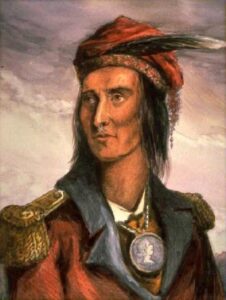Opinion: Who won the War of 1812?
* Previously published in North Grenville Times

By David Shanahan
The North Grenville Times is publishing a series of articles on Indigenous History as part of Indigenous History Month.
Most Canadians have heard of Laura Secord (no, not the chocolate stores), the woman who walked through the night to warn the British of a planned American attack during the War of 1812. Today, she is recognized as a Canadian heroine and a statue of her stands among the Valiants Memorial in Ottawa, 14 key figures from the military history of Canada. But what is not nearly as well known is what happened as a result of her heroic trek on June 23, 1813.
The American attack force was ambushed at Beaver Dam by a force of Canadian militia, British regular troops, and a group of Indigenous warriors. The result for the Americans was disastrous. They couldn’t see their attackers and fired blindly at the trees from behind which the Haudenosaunee warriors fired on them. In all, about 30 Americans were killed or wounded, while the warriors lost just five men. The British commander, James Fitzgibbon, warned the American commander that he should surrender before there was a general massacre of his men.
Afterwards, Fitzgibbon reported that: “Not a shot was fired on our side by any but the Indians. They beat the American detachment into a state of terror, and the only share I claim is taking advantage of a favourable moment to offer them protection from the tomahawk and scalping knife”.
Fitzgibbon was an Irishman who had worked his way up the ranks to his position, and was not, perhaps, guilty of the attitude of smug superiority about the Indigenous allies that was largely true of “better-born” officers who predominated in the British army. And so, he was willing to give credit where it was due.
In fact, the role played by the Indigenous allies in the War of 1812 was pivotal in keeping Canada free of American military conquest. The British and Canadians were vastly outnumbered in terms of population, the United States had a population of eight million. Upper Canada had around 90,000, with around 60 per cent of the inhabitants being of American birth, and it was blithely assumed by the Yanks that Canada would fall easily into their possession. This was not to be the case.
Quite simply, Americans were terrified of the Indians throughout the war, with very good reason, and the British were quite willing to use that fear in most effective ways. Often, it was enough for American troops to know that there were Indigenous warriors coming against them for all thought of fighting to be abandoned, along with forts, supplies, even entire campaigns. The invasion of the Niagara peninsula in 1812 was based on the belief that destroying the Indigenous settlements would, in the words of an American general, “probably induce the Enemy to abandon the province of Upper Canada without Opposition”.
In May 1813, 115 well-armed American troops rowed out in two boats on to Lake Ontario to surrender to a British warship rather than face the continued attacks of just 36 warriors. The American commander explained that “the woods were full of Indians, that he had had to fight with them that morning, and rather than fall into their hands and be massacred”, he surrendered. There were occasions when, being without Indigenous allies, British officers had their men whoop and yell like Indians in order to drive their American opponents to surrender or flee, just at the sound.
A confederacy of Indigenous warriors was brought together by Techumseh, a Shawnee who provided leadership and inspiration during the war, until his death in battle in 1813. The extent to which Indigenous warriors, and their leaders like Tecumseh, won the War of 1812 for the British, and thus saved Upper Canada from annexation and conquest, has been largely forgotten by Canadians today. In the treaty which ended the war, these allies were betrayed, as they had been after the American Revolution in 1783. By 1830, the British had decided that the Indian allies were no longer of military use. Their lands were taken under “treaties”, and the British Government commenced what they called the “Policy of Civilisation”, which was designed to assimilate the Indigenous peoples into the wider Canadian society. It was a dishonourable act of ingratitude for the role they had played in the previous decades.

